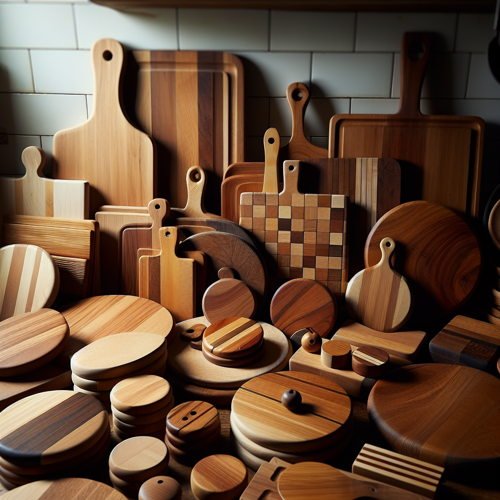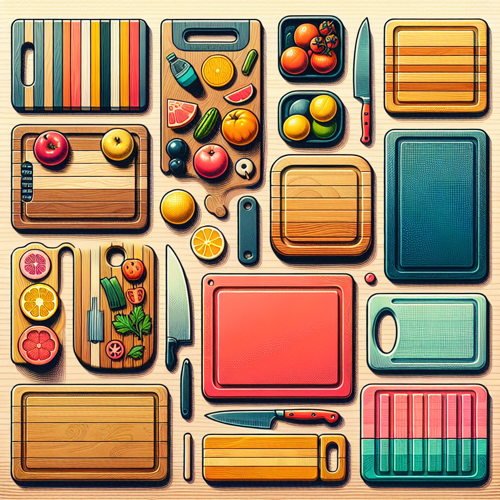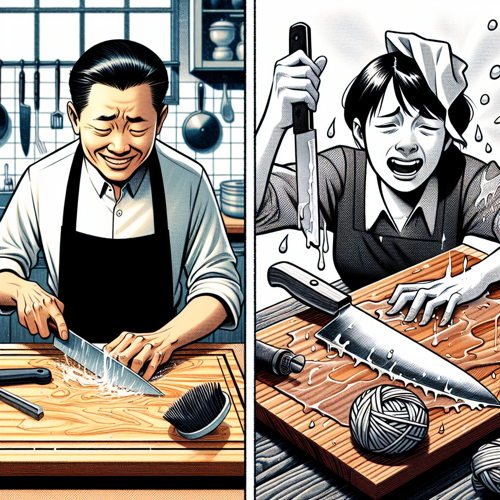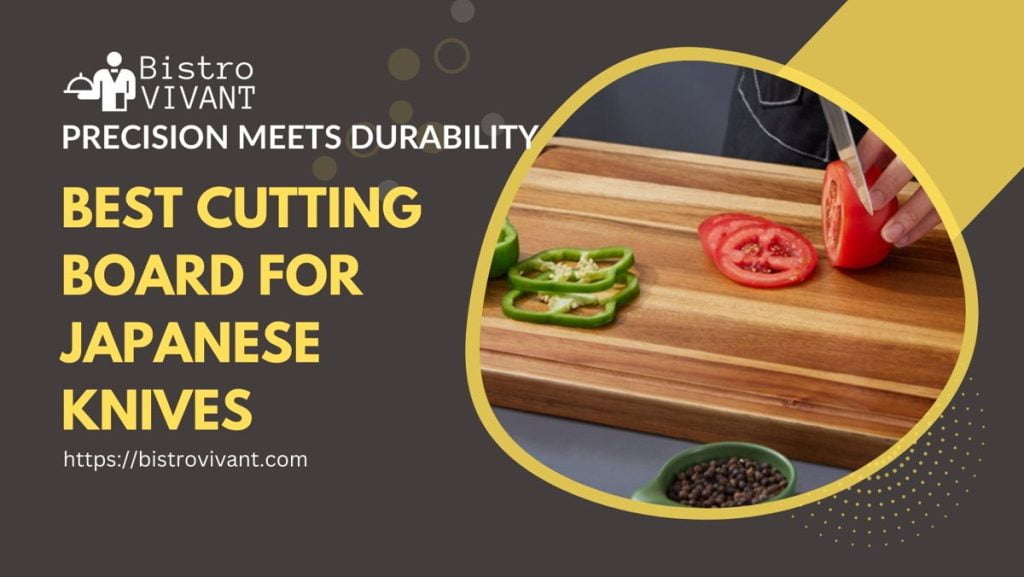Selecting the best cutting board for Japanese knives is a crucial decision for any cooking enthusiast. Japanese knives are known for their unique construction, featuring ultra-thin, razor-sharp blades made from high-carbon steel. These knives demand a cutting board that can withstand their sharpness without dulling their edges.
Choosing the right cutting block can significantly impact the performance and lifespan of your Japanese knives. A poor choice can lead to premature dulling, chipping, or even damaging the knives. Therefore, it’s essential to explore the options available and understand the key factors that make a chopping block ideal for Japanese knives.
In the following sections, we will delve deeper into the characteristics that define the best cutting boards for Japanese knives, considering factors such as material, size, and maintenance. Making an informed decision in this regard will not only protect your investment in these exceptional knives but also enhance your culinary experience.
Characteristics of Japanese Knives
Description of Japanese Knives
Japanese knives exhibit several distinctive characteristics that set them apart:
Sharpness
Japanese knives are celebrated for their razor-sharp blades. Craftsmen use traditional techniques, including meticulous hand-forging and precise angle grinding, to achieve an unparalleled level of sharpness. The keen edge of Japanese knives allows for precise and effortless cutting, making them ideal for intricate tasks like slicing sashimi or julienning vegetables.

Edge Retention
Another hallmark of Japanese knives is their impressive edge retention. This means that the blade remains sharp for an extended period of time, reducing the need for frequent sharpening. The high-quality steel used in Japanese knife construction, often enriched with carbon and other alloys, contributes to this outstanding edge retention. Chefs can work for longer periods without the hassle of constant maintenance.
Construction
Japanese knives are meticulously made. Blades are usually constructed of high-carbon stainless steel or layered Damascus steel with complex designs. Ergonomic handles provide comfort and balance. Japanese knives are durable and functional due to their craftsmanship.
Why do these features necessitate a specific type of cutting board?
While Japanese knives offer exceptional sharpness, edge retention, and construction, these qualities also make them more delicate and prone to damage if not handled with care. Consequently, the choice of a cutting board is critical to preserving the longevity and performance of Japanese knives. Here’s why:
Softness Matters
Japanese knife blades are often thinner and more brittle than their Western counterparts. Using a chopping block that is too hard or abrasive, such as glass or granite, can lead to chipping or dulling of the blade. To maintain the knife’s sharp edge, it is crucial to opt for a cutting board with a softer surface.
Avoid Bamboo and Hardwood
While hardwood and bamboo cutting boards are popular choices, they may not be the best match for Japanese knives. These materials can be too tough for the knife’s delicate edge, causing it to dull prematurely. Instead, consider softer alternatives like hinoki cypress or softwood butcher boards, which are commonly used in Japan.
Gentle on the Edge
Japanese knife blades are known for their precision, and the cutting board should complement this characteristic. A softer cutting block surface absorbs some of the impact during cutting, reducing the stress on the blade and preserving its sharpness over time.
The extraordinary sharpness, edge retention, and construction of Japanese knives necessitate the selection of a cutting board with a softer surface, like hinoki cypress or softwood, to ensure the longevity and optimal performance of these prized kitchen tools.

Types of Cutting Boards
Overview of Different Materials Used in Cutting Boards
Cutting boards come in various materials, each with its own unique characteristics. The most common materials are wood, bamboo, and plastic. Here’s an overview of each:
- Wood: Wooden cutting boards, such as those made from maple, cherry, or walnut, are highly favored for their durability and aesthetic appeal. They provide an excellent surface for cutting and are less likely to dull the blades of Japanese knives. However, they require proper maintenance, including regular oiling and cleaning, to prevent bacterial growth.
- Bamboo: Bamboo chopping blocks are environmentally friendly and have gained popularity due to their hardness and sustainability. They are gentle on Japanese knife blades, preventing premature dulling. Like wooden boards, they also require regular maintenance to ensure hygiene.
- Plastic: Plastic cutting boards, often made from high-density polyethylene (HDPE), are known for their low cost and ease of cleaning. However, they can be harsh on Japanese knife edges, causing them to dull faster. They are also more prone to developing deep grooves where bacteria can accumulate.
Pros and Cons of Each Material in Relation to Japanese Knives
When considering the best cutting board for Japanese knives, it’s essential to weigh the pros and cons of each material.
Wood
- Pros: gentle on Japanese knife blades, durable, and aesthetically pleasing.
- Cons: It requires regular maintenance and may be pricier than other options.
Bamboo
- Pros: environmentally friendly, gentle on knives, and relatively affordable.
- Cons: Requires maintenance; may develop grooves over time.
Durable Plastic/Synthetic
- Pros: affordable, easy to clean, and available in various colors.
- Cons: Can be harsh on Japanese knives, less durable, and prone to wear and tear.
If you prioritize knife longevity and don’t mind regular maintenance, wood or bamboo boards are excellent choices. However, if easy cleaning and affordability are your main concerns, plastic cutting boards might be more suitable.
Remember that proper care and maintenance of your chopping block, regardless of the material, are crucial to ensuring both hygiene and the longevity of your Japanese knives.
Wood and Bamboo Cutting Boards

Wood cutting boards
Wood boards are made from a variety of hardwoods, like maple, walnut, cherry, and oak. They are highly regarded for their durability and aesthetic appeal. The wood’s natural properties help in preserving the sharpness of Japanese knives and prolonging their lifespan.
Bamboo Cutting Boards
Due to their eco-friendliness and durability, bamboo chopping boards have been all the rage recently. Because of its rapid growth rate, bamboo is a great option for eco-conscious people. Cutting boards made of bamboo are renowned for their durability and robustness.
How They Complement Japanese Knives
When it comes to complementing Japanese knives, both wood and bamboo cutting blocks have their advantages.
Softness
Japanese knives are renowned for their sharpness and precision. Wood and bamboo cutting boards provide a softer surface compared to hard materials like glass or plastic. This softness helps absorb some of the impact during cutting, reducing the stress on the knife’s edge. It prevents the knives from dulling prematurely, making them a perfect match for Japanese knives.
Grain Orientation
Both wood and bamboo cutting boards have a natural grain pattern. It’s essential to choose a butcher board with the grain running horizontally, as this orientation provides better support and resistance when cutting. Proper grain orientation helps maintain the integrity of the knife edge and prevents chipping.
Maintenance
Maintaining Japanese knives is crucial, and the choice of chopping block can significantly impact their longevity. Wood and bamboo cutting boards require regular maintenance, including oiling to prevent cracking or warping. This maintenance routine aligns with the care Japanese knives need, making them a compatible pairing.
Their softness, grain orientation, and maintenance requirements make them excellent choices to complement the precision and sharpness of Japanese knives. By choosing the right cutting block, you can ensure that your knives stay in top-notch condition for years to come.
Synthetic Cutting Boards
Plastic and composite cutting boards have gained popularity in recent years due to their affordability and low maintenance. However, it’s essential to understand their characteristics and how they affect Japanese knife blades.

Plastic cutting boards are typically made from high-density polyethylene (HDPE), while composite cutting boards are a mix of wood fibers and resin. Here, we will assess the following aspects:
- Durability: Plastic cutting boards are known for their durability and resistance to moisture, making them less prone to warping or cracking compared to wooden boards. Composite boards also exhibit good durability.
- Knife Impact: Both plastic and composite boards are generally gentle on knife blades. These forgiving surfaces reduce the chance of chipping or dulling Japanese knives, which have sharp edges.
- Maintenance: These cutting boards are relatively easy to clean. They can be washed with soap and water, and some are even dishwasher-safe. However, it’s essential to note that they may develop deep cuts over time, which can harbor bacteria if not cleaned thoroughly.
Ease of Cleaning
Now, let’s delve deeper into how plastic and composite butcher boards impact Japanese knife blades and their cleaning ease:
- Impact on Knife Blades: The softer surface of plastic and composite boards helps preserve the sharpness of Japanese knives. However, it’s crucial to inspect the cutting block regularly for deep cuts or gouges that may compromise blade integrity.
- Ease of Cleaning: Both composite and plastic boards are low-maintenance options. For tougher stains or odors, you can use a mixture of baking soda and water. However, be cautious not to use abrasive scrubbers that may damage the surface.
- Hygiene: While these chopping blocks are easy to clean, it’s important to note that deep cuts or grooves may develop over time, providing a breeding ground for bacteria. Regular maintenance and sanitation are essential to ensuring a hygienic cooking environment.
Size and Stability Considerations
Importance of Size and Stability
The size and stability of a cutting board are of utmost importance when using Japanese knives. Japanese knives are sharp and precise, making them ideal for slicing, dicing, and chopping. To maximize their effectiveness and ensure safety, choosing the right cutting board is imperative.
First and foremost, the size of the butcher board matters significantly. A cutting board should provide ample space to comfortably accommodate the ingredients you intend to prepare. If the butcher block is too small, you may find it challenging to work efficiently, and this could lead to accidents as ingredients spill off the board. Therefore, selecting an adequately sized cutting board is essential to ensuring a smooth and safe culinary experience.

Furthermore, stability is a key consideration. The cutting board must remain firmly in place during use to prevent any unwanted movement. Japanese knives require precise control, and any slippage of the chopping block can result in accidents and injuries.
To enhance stability, look for cutting boards equipped with non-slip features such as rubberized grips or silicone feet. These additions help anchor the board to your countertop, ensuring that it stays put during food preparation.
Recommendations for Ideal Sizes and Features
When choosing a butcher block for Japanese knives, consider the following recommendations for ideal sizes and features:
- Size: Opt for a cutting block that is spacious enough to comfortably accommodate the ingredients you commonly work with. A larger board, such as one measuring 18 inches by 24 inches, provides ample room for cutting and chopping without crowding the workspace.
- Material: Japanese knives are best paired with cutting boards made from materials that are gentle on the blade. Wood, particularly harder woods like maple and cherry, is an excellent choice, as it has a softer surface that won’t dull the knife’s edge. Bamboo is another option known for its durability and knife-friendly properties.
- Thickness: A thicker cutting board offers more stability. Look for boards that are at least 1 inch thick to ensure they remain steady during use.
- Non-slip Features: Seek cutting blocks with non-slip grips or feet. These features help prevent the board from sliding around on your countertop, enhancing safety.
- Maintenance: Consider ease of maintenance. Cutting boards should be easy to clean and maintain. Wooden boards can be cleaned with mild soap and water, but they should not be soaked for extended periods. Regular oiling can also help extend their lifespan.
An appropriately sized board with non-slip features can greatly enhance your safety and efficiency while working with these precision blades. Remember to choose a material that is gentle on your knives and ensure proper maintenance to prolong the cutting board’s life and the sharpness of your Japanese knives.

Maintenance and Care
When it comes to preserving the lifespan of your cutting boards and ensuring the longevity of your Japanese knives, proper maintenance and cleaning are essential. Here are some valuable tips to keep your cutting blocks in top shape:
- Choose the Right Cutting Board Material: Opt for cutting boards made of materials that are gentle on your knives, such as wood, bamboo, or soft plastic. Avoid glass or hard composite boards that can damage the knife’s edge.
- Regular Cleaning: After each use, it’s crucial to clean your cutting board promptly. Rinse it with warm, soapy water, and use a scrub brush or sponge to remove any food residues. Avoid soaking wooden boards, as excessive moisture can cause warping.
- Sanitization: To prevent the buildup of harmful bacteria, sanitize your chopping block regularly. You can use a mixture of vinegar and water or a diluted bleach solution for this purpose. Make sure to rinse thoroughly afterward.
- Avoid Harsh Cleaners: Refrain from using abrasive or harsh chemical cleaners, as they can damage the board’s surface and compromise the knives.
- Proper Drying: After cleaning and rinsing, allow the cutting board to air dry completely. Store it upright to ensure proper ventilation.
- Oil Wooden Boards: If you have a wooden or bamboo cutting board, apply food-grade mineral oil occasionally to keep it from drying out and cracking. This also helps maintain the board’s natural finish.
- Use separate boards. To prevent cross-contamination, have dedicated chopping blocks for different types of food. For example, use one exclusively for meats and another for fruits and vegetables.
Regular maintenance
Regular maintenance of your cutting boards is not just about extending their life but also about safeguarding your health and the quality of your Japanese knives. Here’s why it’s essential:
- Bacteria Prevention: Cutting boards, especially those used for raw meats, can harbor harmful bacteria like Salmonella and E. coli. Proper cleaning and sanitization are crucial to prevent these pathogens from spreading to other foods.
- Knife Protection: Maintaining a clean and well-cared-for butcher board reduces the risk of damaging your precious Japanese knives. A damaged or uneven board surface can cause knives to dull or chip, making them less effective for precision cutting.
- Warping Prevention: Wooden and bamboo cutting blocks are susceptible to warping when exposed to moisture and uneven drying. Regular cleaning and proper drying techniques help prevent this issue, ensuring your board remains flat and stable.
- Taste and Odor Transfer: Neglected cutting boards can retain flavors and odors from previous meals. Regular cleaning ensures that your food’s flavors remain true and uncontaminated.
Top Recommendations
Product prices and availability are accurate as of the date and time indicated on this page and are subject to change. Any price and availability information displayed at the purchase time will apply to this product.
FAQs
Q1: What is the importance of using the right cutting board for Japanese knives?
A: Using the right cutting board is crucial because it can significantly impact the longevity and sharpness of your Japanese knives. The wrong cutting board can dull the blade quickly, while the best one will help maintain its sharpness.
Q2: What makes a chopping block suitable for Japanese knives?
A: The ideal chopping block for Japanese knives is typically made of wood or soft materials like bamboo. These materials are gentle on the knife’s edge and prevent excessive wear. Additionally, a good cutting board should have a self-healing property, which means it can absorb and minimize the impact of knife cuts.
Q3: Are plastic cutting blocks safe for Japanese knives?
A: While plastic cutting blocks are durable and easy to clean, they are not the best choice for Japanese knives. The hardness of plastic can be harsh on the blade, leading to quicker dulling. It’s advisable to opt for wooden or bamboo cutting blocks instead.
Q4: How do I maintain a wooden cutting board for Japanese knives?
A: To keep your wooden cutting board in top condition, regularly clean it with mild soap and warm water, then dry it thoroughly. Apply food-grade mineral oil or beeswax to keep the wood nourished and prevent it from drying out or cracking.
Q5: Can I use a soft rubber or silicone butcher block with Japanese knives?
A: While soft rubber or silicone butcher blocks are gentle on knives, they may not be the best choice for Japanese knives. The flexibility of these materials may not provide the stability required for precise cutting tasks.
Q6: Are end-grain cutting boards better for Japanese knives?
A: Yes, end-grain cutting boards are an excellent choice for Japanese knives. They are designed with the grain of the wood running vertically, which makes them more forgiving on knife edges. The self-healing property of end-grain wood boards helps maintain the knife’s sharpness.

Q7: What is the best size for a cutting board for Japanese knives?
A: Your cutting board should fit your demands, but a large one is best for cutting. Larger boards provide more versatility.
Q8: How can I prevent cross-contamination when using a cutting board for Japanese knives?
A: To avoid cross-contamination, have separate cutting boards for different food types, such as one for meats and another for fruits and vegetables. Regularly sanitize and clean your boards to maintain food safety.
Q9: Where can I find high-quality chopping blocks for Japanese knives?
A: You can find top-notch chopping blocks for Japanese knives at kitchen supply stores, specialty knife shops, or online retailers. Make sure you read reviews and check the material and quality before making a purchase.
Q10: Can I use a cutting board with a built-in knife sharpener for Japanese knives?
A: While some cutting boards come with built-in knife sharpeners, it’s recommended to use a dedicated knife sharpening tool for Japanese knives. These specialized tools ensure precision and protect the knife’s edge.
Conclusion
Japanese knives are precision tools known for their sharpness and delicate blade edges. To ensure their longevity and performance, it is crucial to choose the right butcher block. Wooden cutting boards, made from hardwoods like maple or cherry, offer a balance between durability and knife-friendliness, reducing stress on the knife’s edge. Plastic chopping blocks, on the other hand, are popular due to their affordability and ease of maintenance, but they can be harsh on Japanese knives if they are too hard or have deep grooves.
Size and thickness are also crucial factors when choosing a cutting board for Japanese knives. A larger board provides ample space for precise slicing and dicing, while a thick board provides stability and reduces the risk of warping over time. Regular cleaning and maintenance are essential to ensure the board remains hygienic and free from potential food contamination. Regularly oiling wooden boards and sanitizing plastic ones are essential.
In conclusion, choosing the best cutting board for Japanese knives is crucial for their performance and longevity. By selecting the right material, size, and thickness and maintaining them, you can keep your knives in great shape for years.
 https://bistrovivant.com is a participant in the Amazon Services LLC Associates Program, an affiliate advertising program designed to provide a means for website owners to earn advertising fees by advertising and linking to Amazon (.com,.co.uk,.ca, etc.) and any other website that may be affiliated with the Amazon Service LLC Associates Program. As an Amazon Associate, I earn from qualifying purchases.
https://bistrovivant.com is a participant in the Amazon Services LLC Associates Program, an affiliate advertising program designed to provide a means for website owners to earn advertising fees by advertising and linking to Amazon (.com,.co.uk,.ca, etc.) and any other website that may be affiliated with the Amazon Service LLC Associates Program. As an Amazon Associate, I earn from qualifying purchases.











